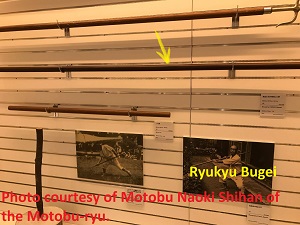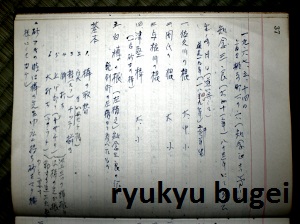Chinen Masami 知念正実 (1898–1976) was an Okinawan bōjutsu expert. He taught privately at his home in Shuri Tōbaru, Okinawa. He named his style Yamani-ryū 山根流 after his grandfather Chinen Sanrā 知念三良 (1842–1925).
In a newspaper article from 1918 Sanrā was described as “Yama no mae no Usumē” (山の前のウスメー). Still today he is called similarly as Yamani Usumē.
Let me explain: Firstly, the name Sanrā 三良 is a typical old-style Okinawan name. The characters are pronounced either Sanrā, Sanrū, or Sandā. This kind of name is a so-called childhood name (warabi-nā). During the Ryūkyū kingdom times commoners (hyakushō 百姓) used this kind of name for their entire life. In case of the higher society levels, such as Okinawan “samurai”, there was no such name as Sanrā 三良. Instead, there was the name Masanrā 真三良, with a prefix Ma~ 真. And among the aristocracy the same name was written Masanrāgani 真三良金, with the suffix ~gani 金. In this way, social status was indicated by the childhood name (warabi-nā).
Secondly, “Yama no mae” or “Yamani” most probably refers to a place “in front of the mountain” or “at the base of the mountain”, or rather a hill.
Thirdly, the noun usumē ウスメー describes an old man or a grandfather from the class of the commoners. That is, a person that had no rank within the royal government organization and whose family did not have an official genealogy. These were the so-called mukei or persons with no genealogy. On the other hand, among the persons and families of rank who had an official genealogy, the old men or grandfathers were called tanmē タンメー. These were the so-called keimochi or “holder of a genealogy”.
In other words, and contrary to popular belief, Chinen Sanrā was obviously a commoner. Therefore it seems to be an unjustified exaggeration to refer to him as Yamani Tanmē, or to add the title of Pēchin to his name, or to call him Masanrā. Just sayin’.

Bo of Chinen Masami on display at the Okinawa Karate Kaikan. Courtesy of Motobu Naoki Shihan of the Motobu-ryu.
Anyway, a lot of schools of Okinawan bōjutsu came in contact with the teachings of Chinen Sanrā during different times. And as had been pointed out initially, Chinen Masami baptized his grandfathers techniques as Yamani-ryū 山根流, and there are a few schools today who say they hand down the original teachings of Chinen Masami.
Since there is a lot of confusion as to what exactly Chinen Masami taught and to whom, it is my great pleasure to offer you the results of a hitherto unpublished interview. It took place on May 14, 1967, in Shuri Tōbaru-chō 2-6, at the home of Chinen Masami.

Interview notes by Nagamine Shōshin of Matsubayashi-ryū. Photo: Andreas Quast.
The interviewer was no less than Nagamine Shōshin of Matsubayashi-ryū. Nagamine Sensei wrote down the results of the interview in a study book which I – with the consent of his son Nagamine Takayoshi Sensei – was able to copy during one of my stays at the Nagamine dōjō (I had authorized access to Nagamine Shōshin’s study room, which had remained untouched for years).
It is a short text that names the kata as well as the kihon techniques taught by Chinen Masami.
May 14, 1967
At Shuri Tōbaru-chō 2, 6 (Chinen Masami)
Chinen Sanrā passed away in 1922, at the age of 83. Date of birth: Born 1839 or 40.
Kata
- Sakugawa no Kon (Dai, Chū, Shō)
- Shūshi no Kon (Dai, Shō)
- Yonegawa no Kon
- Tsuken Bō (alias Sunakaki Bō) (Dai, Shō)
- Shirotaro no Kon
Hidari-kamae [left-handed posture]: considered to have been created by Chinen Sanrā from the left-handed posture of bayonet fencing (jūkenjutsu).
Kihon
- Bō no torikaeshi
- Tsuki (nukite-bō)
- Suso-chitte kiru
- Soku-uchi
- Agichiri
- Ufu-uchi
Great effort and thorough consideration is required until the tip of the bō vibrates in above mentioned three bō techniques (no. 4, 5 and 6).
At the time of sunakaki, hold the tip of the bō wide (flat) as if hurling sand.
I leave it like that, just let me point out two things:
- There were two versions of Tsuken Bō, which were alternatively called Sunakaki Bō.
- There were three versions of Sakugawa no Kon.
I also forgot to note that if you only know some karate, you probably cannot understand what this is about. My sincere condolences.
© 2017 – 2021, Andreas Quast. All rights reserved.
